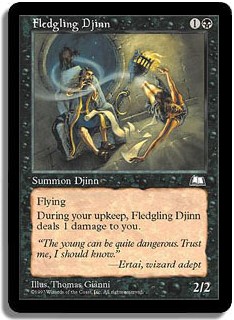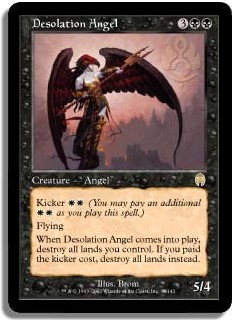The Cube is a custom Limited format — you choose the cards you want to play, to support the decks and archetypes you want to draft. It’s usually
(but not always) intended to be a collection of the best cards in order to produce an interesting, powerful, and infinitely customizable play
environment.
If you’re interesting in learning more about the format, or getting started yourself, these articles are a good place to start:
Evan Erwin article on how to get started
, including information about the different kinds of cubes.
Tom LaPille article
about (among other things!) the history of the cube, getting started, and developing subthemes in each colors.
And this is my column about why I think cube is great.
You don’t necessarily need eight people to draft the cube, but you might need a variant draft format. Here’s Aaron Forsyth’s article on Winston draft, a common alternative
to booster drafting.Â
This week, I want to address some myths about the cube. All of these have a grain of truth (at least), but they don’t tell the whole story, or in my
experience, they’re used too often or are taken too seriously. I’m going to talk about each one and why I feel it falls short of the whole truth about
the cube, in terms of design, deckbuilding, or strategy.
Myth #1 Aggro doesn’t need to care about its life total
This is the idea that aggro can happily Fledgling Djinn, Dark Confidant, and Aftershock all day, and because you’re the beatdown, there’s no risk
involved. That’s not far off if you’re playing against control, but that’s a big if. In any kind of mirror, those cards are actually a big liability.
And in the midrange vs. aggro matchup — where you are already unfavored — taking damage from your own cards makes it easier for your opponent to end
the game before you can burn them out.
That’s not to say that life-loss cards aren’t worth it. Black aggro in particular needs those cards to function at all, and some are good enough even
in slower decks, like Graveborn Muse and Phyrexian Arena. My point isn’t that those cards shouldn’t be run, but that when you construct an aggro deck,
you have to be conscious of every matchup, not just the canonical I’m-the-beatdown plan. That means looking for life gain to offset the drawback and
not doubling up where you don’t need to.
If you’re choosing between W/B and B/R, for example, you could go with white and pick up drawback-free creatures like Stormfront Pegasus and Isamaru to
go with your Bitterblossom, or Faith’s Fetters to offset a few turns of Vampire Lacerator.
In any color, the life gain equipment is killer in the mirror, and in fact, the aggro mirror is where Loxodon Warhammer and Basilisk Collar really
shine. Jitte doesn’t need an excuse to be awesome, but this is yet another reason that it’s a first pick in most decks.
If your opponent is on this plan, and you aren’t, you’re facing an uphill battle, unless you can undo those advantages. Sulfuric Vortex is a fantastic
card in this situation, as you can plan around it (for example, by using an early Lightning Helix) and then drop the Vortex and race.
The fundamental point isn’t that certain cards are or are not good; it’s that when you build a deck, you need to plan for all matchups and not to
neglect the mirror. Aside from cards that mess with your opponent’s math while racing, you can also look to your sideboard for ways to board into a
more midrange-y deck. Remember when pre-Scars of Mirrodin Boros decks had a pair of Baneslayer Angels and maybe even Day of Judgment in the board? Your
cube decks can do the same thing, and it’s a good idea to keep that in mind while drafting — for example, grabbing a midrange creature or sweeper
instead of taking a card that will only be 24th for your maindeck.
Myth #2 Midrange isn’t worth supporting
The logic behind this is that midrange decks will exist regardless, and that therefore you can focus as a designer on the more extreme archetypes.
There’s also the aspect that midrange is something of a dirty word — no one seems to love midrange decks (I suspect in part because it can be
frustrating to lose to control). Or maybe it’s the idea that if you ended up with a midrange deck, it’s because something went wrong in your draft.
The thing is that while midrange doesn’t tend to feel as dominant even when your deck is good, it’s a valid metagame choice because it’s good against
aggro, and more importantly, supporting midrange means your cube will tend to have more interesting interactions. The reason for that is that midrange
creatures fulfill a specific role that the others don’t. Aggro-only creatures are usually vanilla or vanilla-plus-drawback and are chosen solely for
the fact that they are efficient. Control creatures, on the other hand, are basically required to be resilient to removal, and that rules out a lot of
otherwise fun and interesting options.
Midrange creatures, on the other hand, aren’t so high in mana cost that they’re required to win the game on their own but also are allowed to be tuned
towards the longer game. For example, a card like Masked Admirers is amazing in midrange decks — you often rebuy (and thus draw a card) three or more
times in a game. A recurring, reasonable threat that refills your hand? It’s hard not to be onboard.
Another great (and overlooked) midrange card is Okiba-Gang Shinobi. This Blighting-on-a-stick is devastating when it hits, and buying back a Fire Imp
and Eternal Witness is just gravy. Furthermore, unlike cards like Mistblade Shinobi that can only really work once, Okiba-Gang strips away blockers or
lands and actually makes it more likely that it will make contact again.
There are others that fit this mold — Rafiq of the Many, Emeria Angel — but the main point is that these cards produce interesting games and decks.
Myth #3 Control means blue
When I built my guild decks for the cube, the
first thing I had to do was to assign an archetype to each color pair. For most color pairings, it’s easy to come up with the obvious role for that
deck. U/W is a classic control combination, though it’s possible to do something different there — maybe a Reveillark deck with lots of enters the
battlefield effects. The catch is that every color pair has other possibilities as well. Red, white, and black all have strong control aspects, so each
of those colors can support a control deck, with or without blue to back it up. But I still often see every non-blue pair described as aggro or
midrange, and that’s just not true.
It’s true that control takes on a slightly different meaning in that context. A R/W Control deck is unlikely to ever beat a blue one because the
control backbone in those colors — sweepers and targeted removal — aren’t suited to race the backbone of blue decks, which can be slow to set up but
are impenetrable once they do. However, the non-blue deck is likely better against creature decks. Blue can have trouble dealing with a threat
on the board without letting a bigger one resolve. Other control decks don’t have that problem — they have more removal, more sweepers, and can happily
2-for-1 until the time comes to stick a threat of their own. Playing non-blue control can be more of a metagame choice — for example, if you know the
rest of your pod favors creature decks.
To be fair, I think this is more a problem with how people talk about decks in the cube than with how cubes are built, but it still risks being
misleading for new cube drafters. For example, B/W is almost always described as an aggro-disruption deck. But if that’s all you tell someone new to
the cube, they might not see the Desolation Angel control deck that exists or the reanimator strategy that uses both white and black Zombify effects.
I’d like to see cube drafters acknowledge that some colors, especially black and white, have a dual role — not just when we build our cubes but also
when we talk about the role of each color.
Myth #4 The cube is more like Constructed than Limited
There’s a grain of truth in this one, and that is that the power level of the cube is more similar to Constructed than Limited. The cube is of course
miles away from normal Limited in power — that’s what happens when you make a format out of first picks.
But there’s more to Constructed decks than the power level. In Constructed, you have redundancy and a game plan. You make mulligan decisions based on
experience and a specific idea of what the deck should be doing in the early turns. In any draft deck (with the possible exception of a super
tutor/draw-heavy build), you’re going to have games that go completely differently from the others.
Furthermore, even if you manage to goldfish a few times while your opponent finishes deckbuilding, you’re going to continue to learn about your deck as
you play it. You might make changes to your maindeck in the process or start to look for something different in your opening hands.
The closest cube decks get to Constructed is probably something like U/B Reanimator, where you have single copies of reanimation effects and tutors but
can still end up with a similar mix of spells. Boros aggro can get close as well — there’s enough redundancy of one- and two-drops of those colors to
approximate a decks full of four-ofs.
In general, though, the cube feels like high-powered Limited. And that’s important not just for semantics, but for understanding why certain cards do
or don’t work. Cards like Aether Vial that are unquestionably powerful lose value when you can’t be sure to have them on turn 1. And something like
Necropotence — one of the most broken cards ever — doesn’t make it into cubes because the cost is so prohibitive. While there are exceptions — for
example, cards that facilitate combo are better in the cube than in their respective draft formats — the point is that cards for the cube need to be
evaluated in the context of a Limited environment.
That’s it for my cube myths — what about yours? Are there aspects of common knowledge of the cube that you just don’t agree with?
Thea (@wmap on Twitter)


